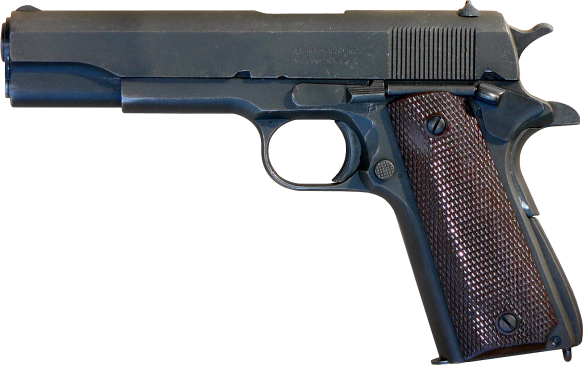Some further small modifications were made as a result of First World War experience, and it became the M1911A1 in 1926. It has served without alteration ever since, as well as being widely sold commercially. It is without doubt the finest combat pistol ever made.
Colt’s Patent Firearms Company was founded in Hartford, Connecticut, in 1848. Its early forties were founded on the famous Colt revolver, but its 1arger connection with military weapons came about by virtue of its alliance with John M Browning the famous designer. As a result, several of the weapons have been unofficially known as ‘Colt–Browning’ guns, though the actual official designation has favoured either one name or the other.
Note that the Browning 0.30-in (7.62-mm) machine-gun, was adopted by the RAF, was frequently called the ‘Colt- Browning’ in official British documents.
The first design under the Colt name was the Browning-designed Machine-Gun M 1895, more commonly called the ‘Colt Potato-Digger’. This was among the first successful gas-operated machine-gun, but instead of the now-familiar horizontal gas cylinder with l piston reciprocating inside it, the action was driven by an arm hinged beneath the barrel. As the bun was fired, gas escaped through a port beneath the barrel and impinged on the end of this arm driving it downward. By suitable linkage, this movement operated the breech mechanism.
So long as it was mounted on a tripod it was satisfactory, but inadvertently mounting it too close to the ground led to the arm striking the earth-hence the nickname. The M 1895 was purchased by the US Navy in 6-mm (0. 236-in) caliber and later, as the M1906, by the US Army in 7.62-mm (0.30-in) caliber, and it was widely sold abroad. The design was then modified in 1917 to become the Marlin machine-gun.
The most famous and long-serving military design of the Colt company is the US Army 0.45-in (11.4-mm) Automatic Pistol M1911A1. Another Browning design, this originated in 1900 as a commercial weapon in 0.38-in (9.65-mm) caliber, introducing the ‘swinging link’ locking system. The barrel was supported in the frame by two hinged links, one beneath the muzzle and one beneath the breech. An enveloping slide covered the barrel and also formed the breech block. When the slide was forced forward by the return spring, the breech portion, pressing against the base of the cartridge in the chamber, forced the barrel forward and, by the action of the links, upward. This brought two ribs on top of the barrel into engagement with two grooves inside the slide and thus locked breech and barrel together while the pistol was fired. As the slide recoiled, so the barrel was dragged back, still locked, but as the links hinged, so the barrel was pulled down to free the lugs; the barrel then stopped and the slide continued to recoil, ejecting the spent case and reloading the chamber on the return stroke.
In 1907 the US Army carried out an exhaustive trial into competing handgun, stipulating that all must fire a 0.45-in (11.4- mm) cartridge with 230 grain bullet. The Colt was the most successful and, after some small modifications, the design was accepted as the M1911 pistol. The principal change was the removal of the front link, replacing it by allowing the barrel to slide in a bushing. Some further small modifications were made as a result of First World War experience, and it became the M1911A1 in 1926. It has served without alteration ever since, as well as being widely sold commercially. It is without doubt the finest combat pistol ever made.
The Colt company manufactured, of course the Browning machine-guns, and they also, as contractors, manufactured many other well-known weapons such as the Thompson submachine-gun and the Vickers machine-gun.
